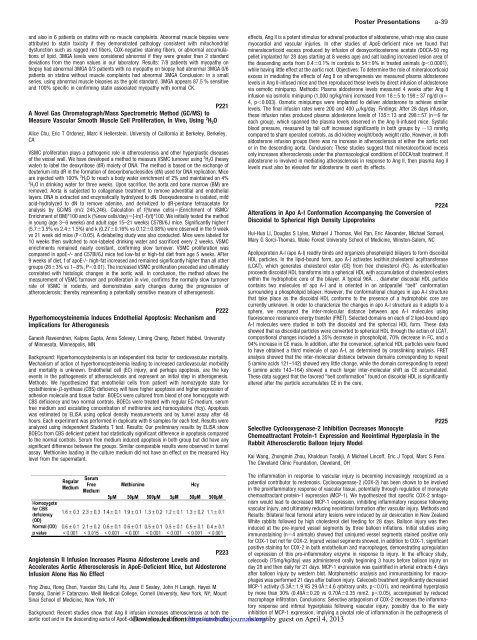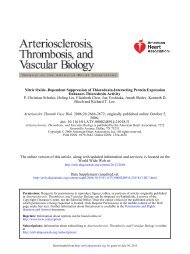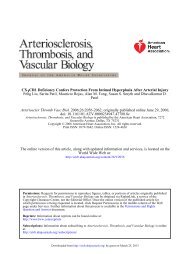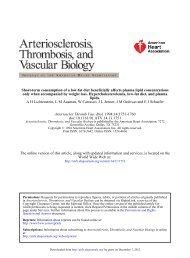Oral Presentations - Arteriosclerosis, Thrombosis, and Vascular ...
Oral Presentations - Arteriosclerosis, Thrombosis, and Vascular ...
Oral Presentations - Arteriosclerosis, Thrombosis, and Vascular ...
You also want an ePaper? Increase the reach of your titles
YUMPU automatically turns print PDFs into web optimized ePapers that Google loves.
<strong>and</strong> also in 6 patients on statins with no muscle complaints. Abnormal muscle biopsies were<br />
attributed to statin toxicity if they demonstrated pathology consistent with mitochondrial<br />
dysfunction such as ragged red fibers, COX-negative staining fibers, or abnormal accumulations<br />
of lipid. 3MGA levels were considered abnormal if they were greater than 2 st<strong>and</strong>ard<br />
deviations from the mean values in our laboratory. Results: 7/8 patients with myopathy on<br />
biopsy had abnormal 3MGA 0/3 patients with no myopathy on biopsy had abnormal 3MGA 0/6<br />
patients on statins without muscle complaints had abnormal 3MGA Conclusion: In a small<br />
series, using abnormal muscle biopsies as the gold st<strong>and</strong>ard, 3MGA appears 87.5 % sensitive<br />
<strong>and</strong> 100% specific in confirming statin associated myopathy with normal CK.<br />
P221<br />
A Novel Gas Chromatograph/Mass Spectrometric Method (GC/MS) to<br />
Measure <strong>Vascular</strong> Smooth Muscle Cell Proliferation, In Vivo, Using 2H2O Alice Chu, Eric T Ordonez, Marc K Hellerstein. University of California at Berkeley, Berkeley,<br />
CA<br />
VSMC proliferation plays a pathogenic role in atherosclerosis <strong>and</strong> other hyperplastic diseases<br />
of the vessel wall. We have developed a method to measure VSMC turnover using 2 H 2O (heavy<br />
water) to label the deoxyribose (dR) moiety of DNA. The method is based on the exchange of<br />
deuterium into dR in the formation of deoxyribonucleosides (dN) used for DNA replication. Mice<br />
are injected with 100% 2 H 2O to reach a body water enrichment of 2% <strong>and</strong> maintained on 4%<br />
2 H2O in drinking water for three weeks. Upon sacrifice, the aorta <strong>and</strong> bone marrow (BM) are<br />
removed. Aorta is subjected to collagenase treatment to remove adventitial <strong>and</strong> endothelial<br />
layers. DNA is extracted <strong>and</strong> enzymatically hydrolyzed to dN. Deoxyadenosine is isolated, mild<br />
acid-hydrolyzed to dN to remove adenine, <strong>and</strong> derivitized to dR-pentane tetraacetate for<br />
analysis by GC/MS (m/z 245,246). Calculation of f(%new cells)(Enrichment of VSMC/<br />
Enrichment of BM)*100 <strong>and</strong> k (%new cells/day){-ln(1-f)/t}*100. We initially tested the method<br />
in young (age 3–6 weeks) <strong>and</strong> adult (age 15–21 weeks) C57Bl/6J mice. Significantly higher f<br />
(5.73.5% vs 2.41.5%) <strong>and</strong> k (0.270.16% vs 0.120.08%) were observed in the 9 week<br />
vs 21 week old mice (P0.05). A delabeling study was also conducted. Mice were labeled for<br />
10 weeks then switched to non-labeled drinking water <strong>and</strong> sacrificed every 2 weeks. VSMC<br />
enrichments remained nearly constant, confirming slow turnover. VSMC proliferation was<br />
compared in apoE-/- <strong>and</strong> C57Bl/6J mice fed low-fat or high-fat diet from age 5 weeks. AFter<br />
9 weeks of diet, f of apoE-/- high-fat increased <strong>and</strong> remained significantly higher than all other<br />
groups (263% vs 1–8%, P0.01). The increased VSMC proliferation preceded <strong>and</strong> ultimately<br />
correlated with histologic changes in the aortic wall. In conclusion, the method allows the<br />
measurement of VSMC turnover <strong>and</strong> proliferation in vivo, confirms the normally slow turnover<br />
rate of VSMC in rodents, <strong>and</strong> demonstrates early changes during the progression of<br />
atherosclerosis; thereby representing a potentially sensitive measure of atherogenesis.<br />
P222<br />
Hyperhomocysteinemia Induces Endothelial Apoptosis: Mechanism <strong>and</strong><br />
Implications for Atherogenesis<br />
Ganesh Raveendran, Kalpna Gupta, Anna Solevey, Liming Cheng, Robert Hebbel. University<br />
of Minnesota, Minneapolis, MN<br />
Background: Hyperhomocysteinemia is an independent risk factor for cardiovascular mortality.<br />
Mechanism of action of hyperhomocysteinemia leading to increased cardiovascular morbidity<br />
<strong>and</strong> mortality is unknown. Endothelial cell (EC) injury, <strong>and</strong> perhaps apoptosis, are the key<br />
events in the pathogenesis of atherosclerosis <strong>and</strong> represent an initial step in atherogenesis.<br />
Methods: We hypothesized that endothelial cells from patient with homozygote state for<br />
cystathionine--synthase (CBS) deficiency will have higher apoptosis <strong>and</strong> higher expression of<br />
adhesion molecule <strong>and</strong> tissue factor. BOECs were cultured from blood of one homozygote with<br />
CBS deficiency <strong>and</strong> two normal controls. BOECs were treated with regular EC medium, serum<br />
free medium <strong>and</strong> escalating concentration of methionine <strong>and</strong> homocysteine (Hcy). Apoptosis<br />
was estimated by ELISA using optical density measurements <strong>and</strong> by tunnel assay after 48<br />
hours. Each experiment was performed in duplicate with 8 samples for each test. Results were<br />
analyzed using independent Students T test. Results: Our preliminary results by ELISA show<br />
BOECs from CBS deficient patient had statistically significant difference in apoptosis compared<br />
to the normal controls. Serum free medium induced apoptosis in both group but did have any<br />
significant difference between the groups. Similar comparable results were observed in tunnel<br />
assay. Methionine loading in the culture medium did not have an effect on the measured Hcy<br />
level from the supernatant.<br />
Poster <strong>Presentations</strong> a-39<br />
effects, Ang II is a potent stimulus for adrenal production of aldosterone, which may also cause<br />
myocardial <strong>and</strong> vascular injuries. In other studies of ApoE-deficient mice we found that<br />
mineralocorticoid excess produced by infusion of deoxycorticosterone acetate (DOCA-50 mg<br />
pellet implanted for 28 days starting at 8 weeks age) <strong>and</strong> salt loading increased lesion area of<br />
the descending aorta from 0.40.1% in controls to 549% in treated animals (p0.0001),<br />
while having little effect at the aortic root. Objectives: To determine the role of mineralocorticoid<br />
excess in mediating the effects of Ang II on atherogenesis we measured plasma aldosterone<br />
levels in Ang II-infused mice <strong>and</strong> then reproduced these levels by direct infusion of aldosterone<br />
via osmotic minipump. Methods: Plasma aldosterone levels measured 4 weeks after Ang II<br />
infusion via osmotic minipump (1,000 ng/kg/min) increased from 185 to19837 ng/dl (n<br />
4, p0.003). Osmotic minipumps were implanted to deliver aldosterone to achieve similar<br />
levels. The final infusion rates were 200 <strong>and</strong> 400 /kg/day. Findings: After 28 days infusion,<br />
these infusion rates produced plasma aldosterone levels of 13513 <strong>and</strong> 29857 (n6 for<br />
each group), which spanned the plasma levels observed in the Ang II-infused mice. Systolic<br />
blood pressure, measured by tail cuff increased significantly in both groups by 13 mmHg<br />
compared to sham operated controls, as did kidney weight/body weight ratio. However, in both<br />
aldosterone infusion groups there was no increase in atherosclerosis at either the aortic root<br />
or in the descending aorta. Conclusion: These studies suggest that mineralocorticoid excess<br />
only increases atherosclerosis under the pharmacological conditions of DOCA/salt treatment. If<br />
aldosterone is involved in mediating atherosclerosis in response to Ang II, then plasma Ang II<br />
levels must also be elevated for aldosterone to exert its effects.<br />
Alterations in Apo A-I Conformation Accompanying the Conversion of<br />
Discoidal to Spherical High Density Lipoproteins<br />
Hui-Hua Li, Douglas S Lyles, Michael J Thomas, Wei Pan, Eric Alex<strong>and</strong>er, Michael Samuel,<br />
Mary G Sorci-Thomas. Wake Forest University School of Medicine, Winston-Salem, NC<br />
P224<br />
Apolipoprotein A-I (apo A-I) readily binds <strong>and</strong> organizes phospholipid bilayers to form discoidal<br />
HDL particles. In the lipid-bound form, apo A-I activates lecithin:cholesterol acyltransferase<br />
(LCAT), which generates cholesterol ester (CE) from free cholesterol (FC). As esterification<br />
proceeds discoidal HDL transforms into a spherical HDL with accumulation of cholesterol esters<br />
within the hydrophobic core of the bilayer. A typical 96Ã. . . diameter discoidal HDL particle<br />
contains two molecules of apo A-I <strong>and</strong> is oriented in an antiparallel “belt” conformation<br />
surrounding a phospholipid bilayer. However, the conformational changes in apo A-I structure<br />
that take place as the discoidal HDL conforms to the presence of a hydrophobic core are<br />
currently unknown. In order to characterize the changes in apo A-I structure as it adapts to a<br />
sphere, we measured the inter-molecular distance between apo A-I molecules using<br />
fluorescence resonance energy transfer (FRET). Selected domains on each of 2 lipid-bound apo<br />
A-I molecules were studied in both the discoidal <strong>and</strong> the spherical HDL form. These data<br />
showed that as discoidal particles were converted to spherical HDL through the action of LCAT,<br />
compositional changes included a 35% decrease in phospholipid, 70% decrease in FC, <strong>and</strong> a<br />
94% increase in CE mass. In addition, after the conversion, spherical HDL particles were found<br />
to have obtained a third molecule of apo A-I, as determined by crosslinking analysis. FRET<br />
analysis showed that the inter-molecular distance between domains corresponding to repeat<br />
5 (amino acids 121–142) showed very little change, while the domain corresponding to repeat<br />
6 (amino acids 143–164) showed a much larger inter-molecular shift as CE accumulated.<br />
These data suggest that the favored “belt conformation” found on discoidal HDL is significantly<br />
altered after the particle accumulates CE in the core.<br />
P225<br />
Selective Cyclooxygenase-2 Inhibition Decreases Monocyte<br />
Chemoattractant Protein-1 Expression <strong>and</strong> Neointimal Hyperplasia in the<br />
Rabbit Atherosclerotic Balloon Injury Model<br />
Kai Wang, Zhongmin Zhou, Khaldoun Tarakji, A Michael Lincoff, Eric J Topol, Marc S Penn.<br />
The Clevel<strong>and</strong> Clinic Foundation, Clevel<strong>and</strong>, OH<br />
Angiotensin II Infusion Increases Plasma Aldosterone Levels <strong>and</strong><br />
P223<br />
The inflammation in response to vascular injury is becoming increasingly recognized as a<br />
potential contributor to restenosis. Cyclooxygenase-2 (COX-2) has been shown to be involved<br />
in the proinflammatory response of vascular tissue, potentially through regulation of monocyte<br />
chemoattractant protein-1 expression (MCP-1). We hypothesized that specific COX-2 antagonism<br />
would lead to decreased MCP-1 expression, inhibiting inflammatory response following<br />
vascular injury, <strong>and</strong> ultimately reducing neointimal formation after vascular injury. Methods <strong>and</strong><br />
Results: Bilateral focal femoral artery lesions were induced by air desiccation in New Zeal<strong>and</strong><br />
White rabbits followed by high cholesterol diet feeding for 28 days. Balloon injury was then<br />
induced at the pre-injured vessel segments by three balloon inflations. Initial studies using<br />
immunostaining (n4 animals) showed that uninjured vessel segments stained positive only<br />
for COX-1 but not for COX-2. Injured vessel segments showed, in addition to COX-1, significant<br />
positive staining for COX-2 in both endothelium <strong>and</strong> macrophages, demonstrating upregulation<br />
of expression of this pro-inflammatory enzyme in response to injury. In the efficacy study,<br />
celecoxib (75mg/kg/day) was administered orally beginning 3 hours before balloon injury on<br />
Accelerates Aortic Atherosclerosis in ApoE-Deficient Mice, but Aldosterone day 28 <strong>and</strong> then daily for 21 days. MCP-1 expression was quantified in arterial extracts 4 days<br />
Infusion Alone Has No Effect<br />
after balloon injury by western blot. Morphometric analysis <strong>and</strong> immunostaining for macrophages<br />
was performed 21 days after balloon injury. Celecoxib treatment significantly decreased<br />
Ying Zhou, Rong Chen, Yuexian Shi, Lufei Hu, Jean E Sealey, John H Laragh, Hayes M<br />
MCP-1 activity (5.3Â1.9 VS 29.0Â4.6 arbitrary units, p0.01), <strong>and</strong> neointimal hyperplasia<br />
Dansky, Daniel F Catanzaro. Weill Medical College, Cornell University, New York, NY; Mount by more than 30% (0.49Â0.20 vs 0.70Â0.35 mm2, p0.05), accompanied by reduced<br />
Sinai School of Medicine, New York, NY<br />
macrophage infiltration. Conclusions: Selective antagonism of COX-2 decreases the inflammatory<br />
response <strong>and</strong> intimal hyperplasia following vascular injury, possibly due to the early<br />
Background: Recent studies show that Ang II infusion increases atherosclerosis at both the inhibition of MCP-1 expression, implying a pivotal role of inflammation in the pathogenesis of<br />
aortic root <strong>and</strong> in the descending aorta of ApoE-deficient Downloaded mice. In addition from<br />
tohttp://atvb.ahajournals.org/ its vasoconstrictor restenosis. by guest on April 4, 2013














